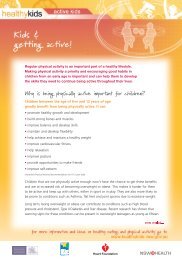I Move We Move - Good For Kids - NSW Government
I Move We Move - Good For Kids - NSW Government
I Move We Move - Good For Kids - NSW Government
Create successful ePaper yourself
Turn your PDF publications into a flip-book with our unique Google optimized e-Paper software.
Culturally appropriate<br />
Physical activity settings offer excellent opportunities for children to learn to recognise differences<br />
and similarities, working with others, and to understand that different customs or cultural practices.<br />
Ensuring cultural appropriateness includes respecting differences and providing opportunities for<br />
active play and learning experiences appropriate and relevant to children from a variety of cultural<br />
backgrounds. There may be significant differences in the physical activity culture of families, even in<br />
fairly homogeneous groups2 .<br />
It is important to invite and engage families and the wider community to participate in physical<br />
activity. Families sharing knowledge, games and activities which are unique to their culture or<br />
heritage can help develop a sense of identity and unity between families. To develop understanding<br />
and respect for Aboriginal cultures and promote stronger links with local Aboriginal communities;<br />
services can seek advice from parents and community members on familiar words (e.g. play) and<br />
traditional children's games and dances that would be appropriate for use in your service. The<br />
Aboriginal and Torres Strait Islander Early Childhood Sector Advisory Group (ATSIECSAG) website<br />
is a useful reference (see Section Two of the Guide, page 2.14).<br />
Co-creating provocations for physical activity that are reflective of each child’s unique social and<br />
cultural influences can assist in ensuring that the provocations are relevant, meaningful and inclusive.<br />
Safety<br />
It is important to check with families for any health issues that would need to be taken into<br />
account for children’s participation in physical activity. <strong>For</strong> example a latex allergy in relation to<br />
use of balloons; breathing problems that may be triggered by exertion or materials used (such as<br />
feathers); or any joint or muscular problems that impact on the type of physical activity or the way<br />
that they can be undertaken.<br />
The physical environment is also another important consideration, and should comply with licensing<br />
and accreditation requirements and risks avoided or managed as appropriate. As with any other<br />
important issue, safety for physical activity needs to be covered in your policies.<br />
See Section Six, Active Early Childhood Environments (pages 6.6) for information<br />
on risk management.<br />
See Section Two, Whole of Service Approach (page 2.12) for an example of a<br />
physical activity policy.<br />
I <strong>Move</strong> <strong>We</strong> <strong>Move</strong>, The Guide Edition 1 August 2009<br />
AREA HEALTH SERVICE<br />
3.4




